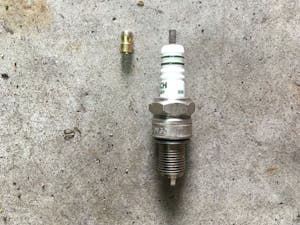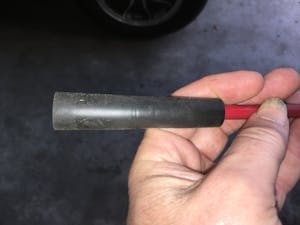Media | Articles
The tip of the problem with spark plugs and wires
A friend of mine messaged me recently asking if I could walk him through the process of adjusting the valves on a newly installed engine in his BMW 2002. Since, as I wrote in this story a few years ago, valve adjustment needs to be done on a dead-cold engine; the thing to do was for me to come to him. It wasn’t hardship for me to drive one of the cars the hour from Newton out to Worcester on a cool Saturday morning on Memorial Day weekend. The fact that my friend is a veteran made me all the happier to do him the favor.
Since valve adjustment requires rotating each piston to top dead center in its cylinder, and since that’s easiest to do with the spark plugs removed, I disconnected all four plug wires and pulled the plugs out. This allowed me to easily rotate the engine by grabbing the cooling fan and leaning against the fan belt with the heel of my hand to keep it tight.
As I was working, we chatted, and he told me some of the trials and tribulations of this engine. It was a performance motor, with 10:1 pistons, a Schrick 306-degree cam, double valve springs, valve shaft locking collars to insure that the rockers don’t laterally float on the shafts, and dual Weber 40DCOE side-draft carbs. However, he said that, a year after installation, it still isn’t running quite right; it stumbles on light throttle despite two shops having had a look at it. It sounded like a carburetor issue, maybe jetting, but I’m really much better with mechanically injected BMW engines.
When I finished the valve adjustment, I screwed the spark plugs back in, then began to place the spark plug wires back on the plugs. The car had thick silicone plug wires with tight-fitting ends (boots) that snugly fit the plugs, but when I put the first one on, I couldn’t feel the positive little snap that accompanies the connector inside the boot locking onto the tip of the plug. I initially said to my friend, “I’ll leave these for you to put on ’cause they feel kind of funny to me,” but I couldn’t help looking into it.
What I found was very surprising.
Marketplace
Buy and sell classics with confidence
Anyone who’s ever bought spark plugs knows that most of them come with little “terminal nuts” that are about the size of a pencil eraser. They thread onto the thin posts that are about the diameter of the lead in a pencil at the top of the plugs.

Whether you leave the terminal nuts threaded on or take them off depends on which ends are on your plug wires. On my vintage BMWs, the original spark plug ends are a brown Bakelite plastic, inside of which is the little metal connector that’s attached to the end of the wire. This is meant to slide over the bare threaded post. If you look at the photo below, you can see a little spring clip that extends into the hole. When you slide a plug wire end like this over the bare threaded tip of the spark plug, you can feel that clip as it slides down over the ridges of the threads, leaving no doubt that you have it on.

The other type of plug wire end is meant to be used with the terminal nut. The connector inside it has a larger diameter. It makes a less positive thock as it snaps onto the nut.

What I found on my friend’s car was that the plug wires had ends on them that were meant for terminal nuts, but the plugs in his car didn’t have them; they just had bare threaded posts. Most surprising. I showed it to him, and he shook his head. “The last shop I paid to look at the stumbling problem replaced the plugs.”
You’d think that this couldn’t happen. And you’d be partially right. Sometimes aftermarket plug wires, like the ones on my friend’s car, have different ends than the originals, but if you’re unaware of it, you generally find it out as soon as you try to fit them onto the plugs. If the plug wire ends were for bare threaded tips and the plugs have terminal nuts on them, you’d know it immediately because the ends wouldn’t slide and lock onto anything; you wouldn’t feel the little clip running over the tops of the threads and you’d know something was wrong.
But the converse isn’t necessarily true, and here’s why. While you’d think that the large terminal-nut-style connector would just flop around on the small threaded post, what happened on my friend’s car was that the plug wire boots were a rubbery silicone that had the connector recessed up inside it. This made it so that the silicone boot gripped the ceramic shaft of the plugs so snugly that, even though the electrical connector didn’t snap onto the tip of the plug, it was held in place and didn’t come off without a good tug. This was what I was feeling that I didn’t understand.


My friend rummaged around in his garage and found a set of terminal nuts. I threaded them onto the ends of the plugs and verified that I could now feel the little snap of the connectors locking on. He started the car and said that, with the adjusted valves, it obviously sounded much quieter, but he’d need to drive it to see if the stumble was gone. I was certain that it would be, but he needed to move a few cars to get the 2002 out. He thanked me, and I headed home.
Later in the day, I texted him a reminder to let me know how the car was running with the plug wires actually making electrical contact. I was stunned when I received a text saying “Absolutely no difference.” I can only assume that, previously, even if the plug wires weren’t snapped onto the tips of the plugs, they were either in physical contact or were close enough for the spark to arc across.
And thus we learn the real lesson of this week’s post: Even when you fix things that are obviously wrong, sometimes they’re not responsible for the problem.
***
Rob Siegel has been writing the column The Hack Mechanic™ for BMW CCA Roundel magazine for 34 years and is the author of five automotive books. His new book, Resurrecting Bertha: Buying back our wedding car after 26 years in storage, is available on Amazon, as are his other books, like Ran When Parked. You can order personally inscribed copies here.














